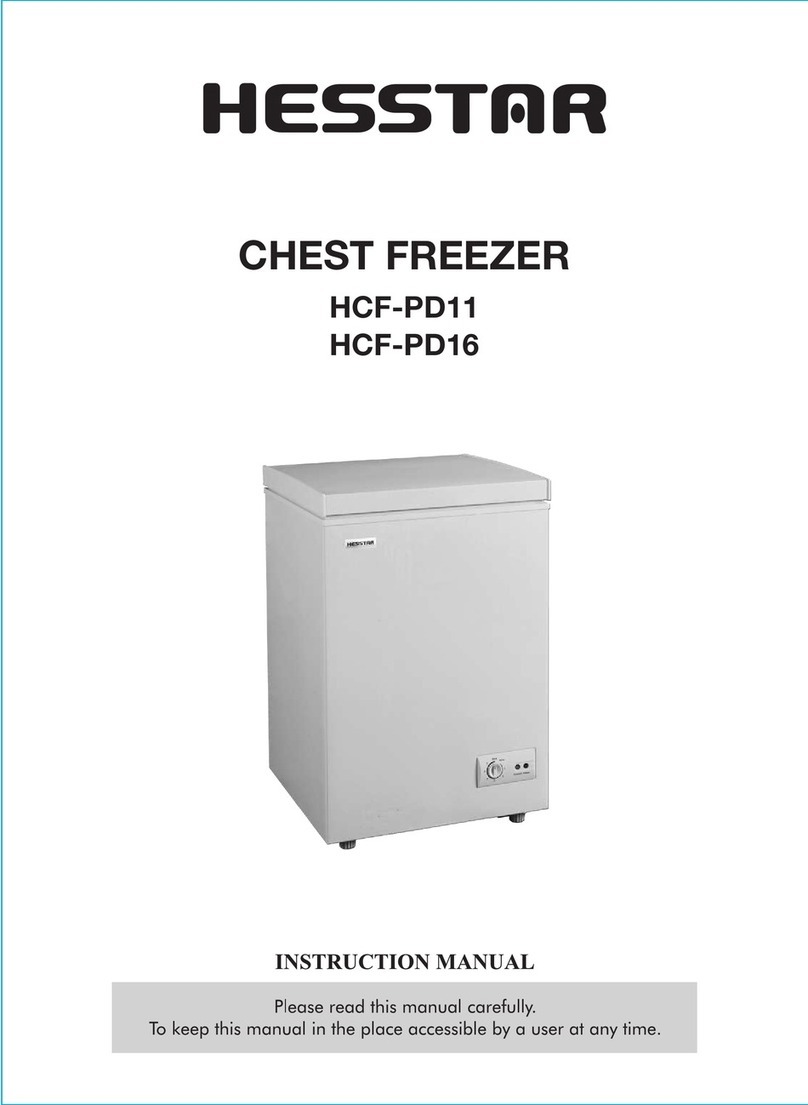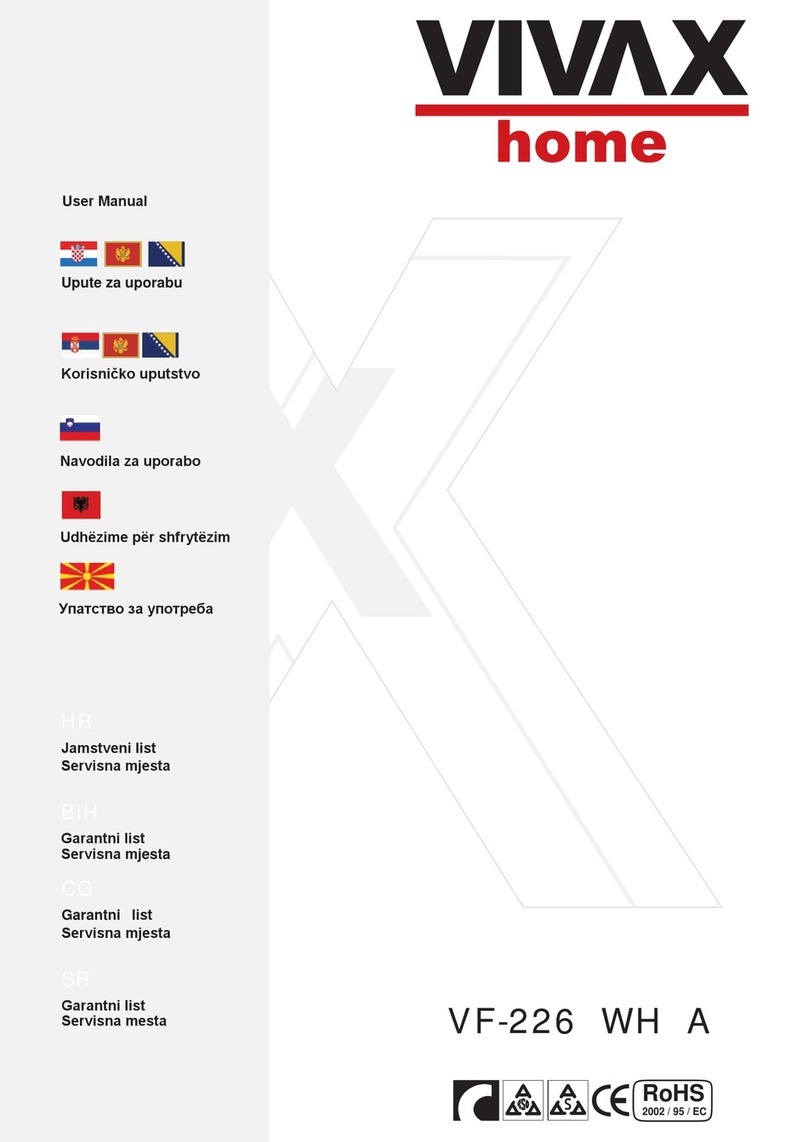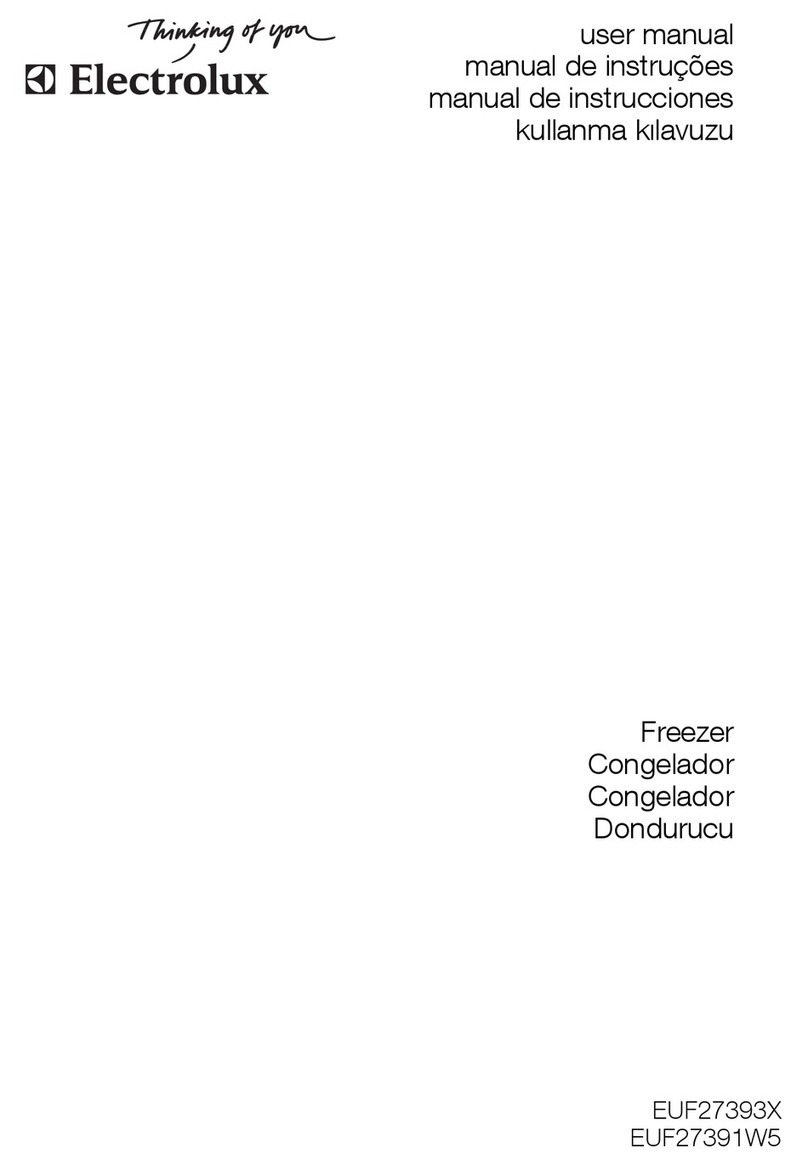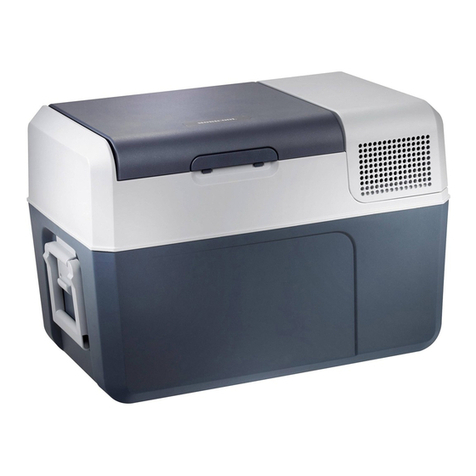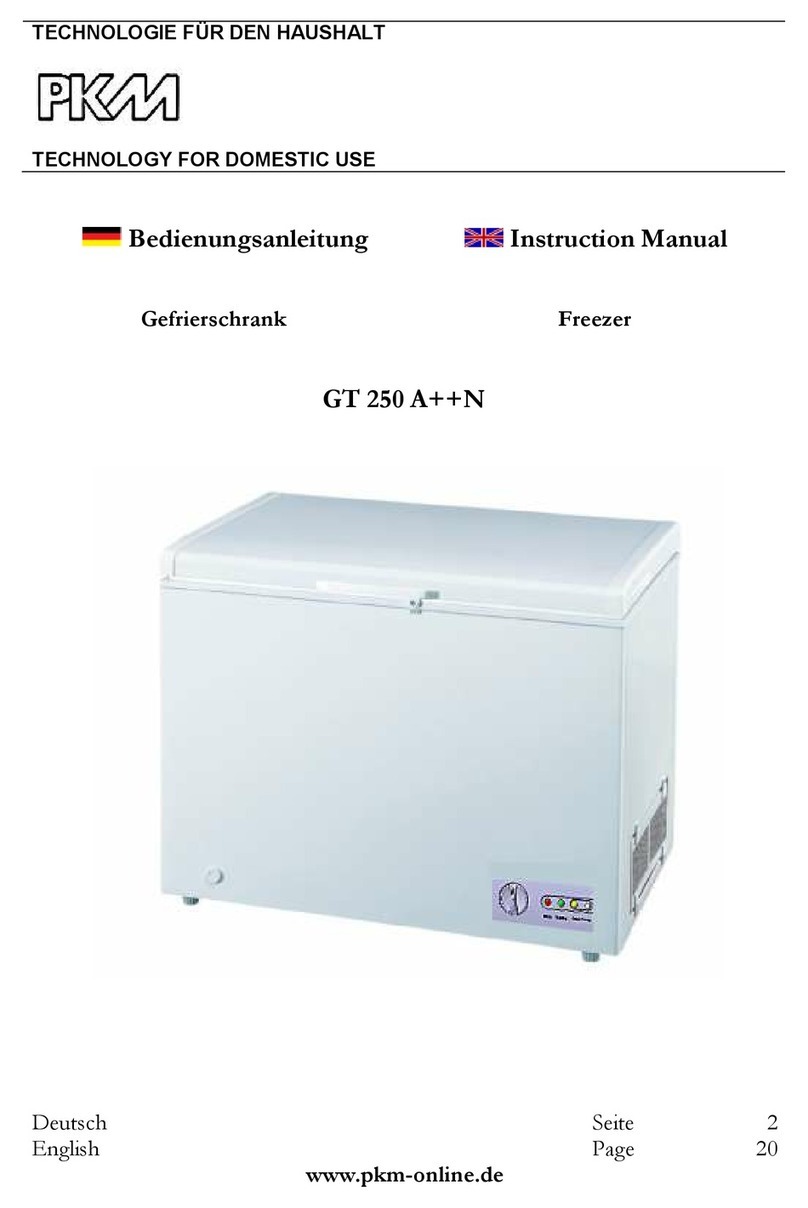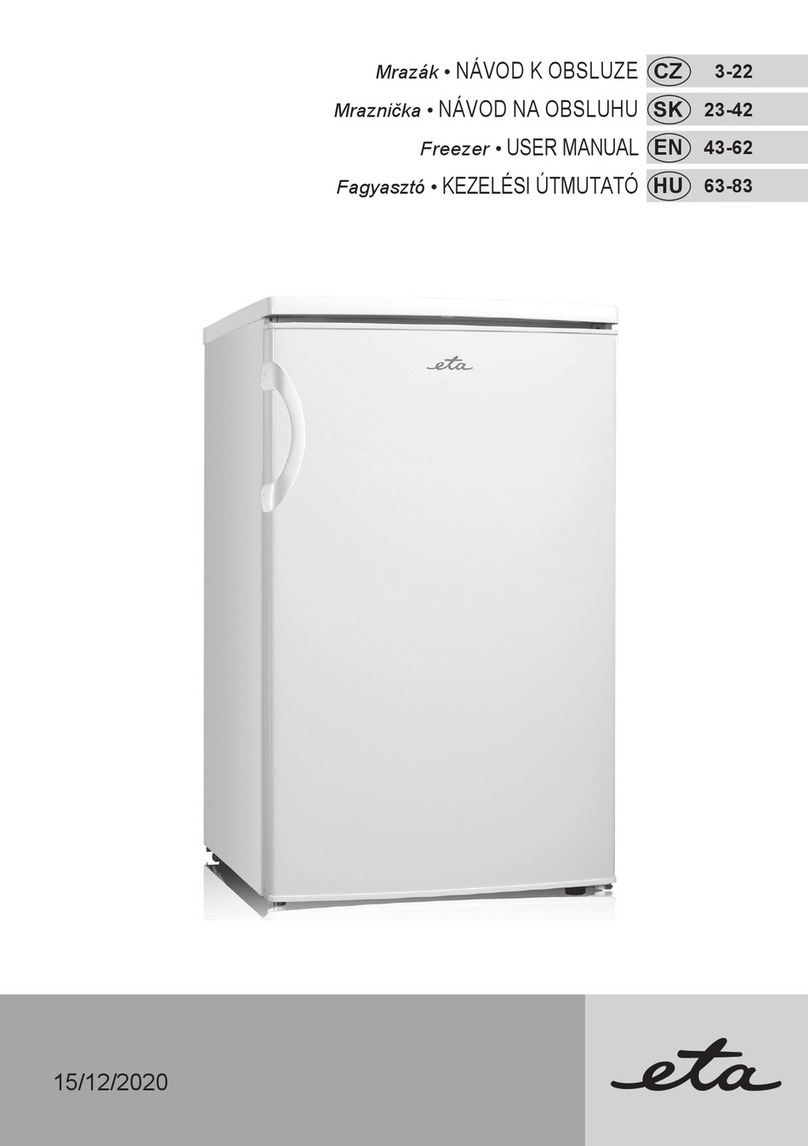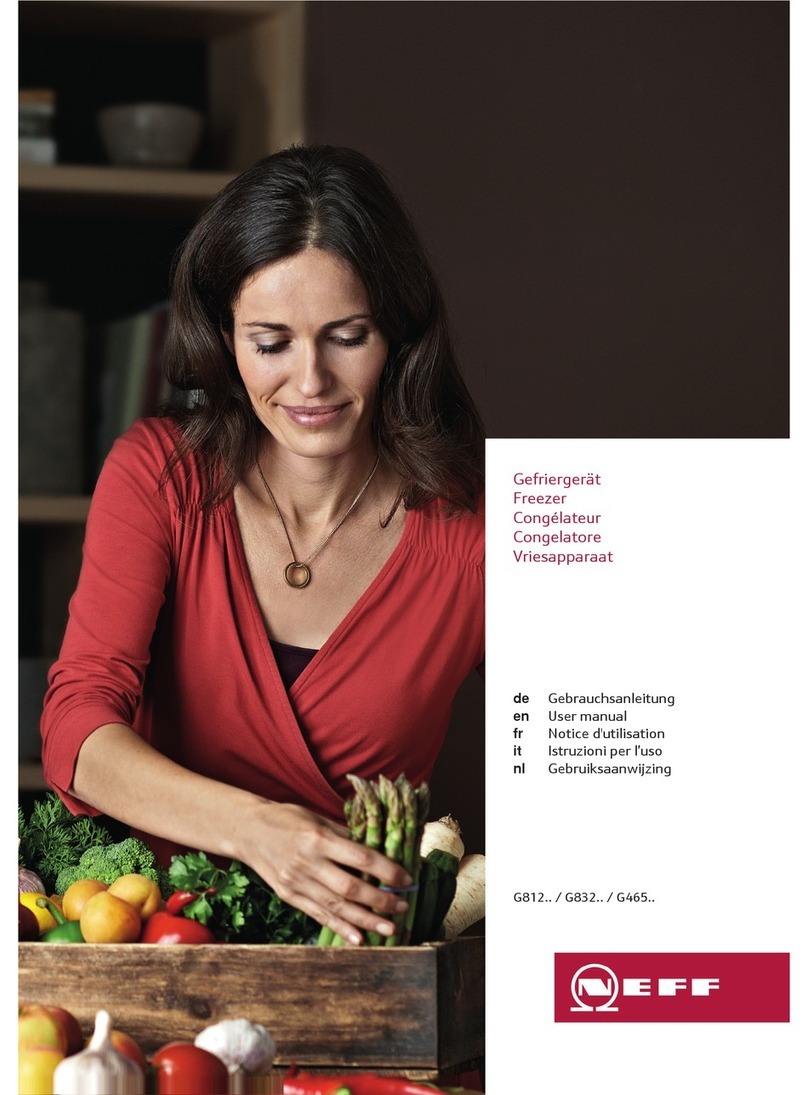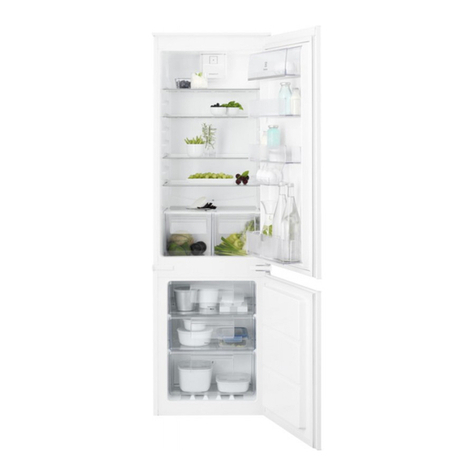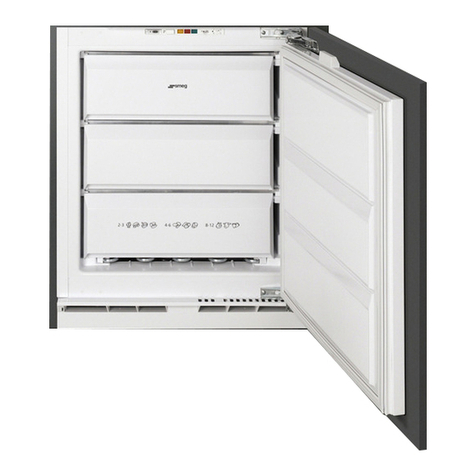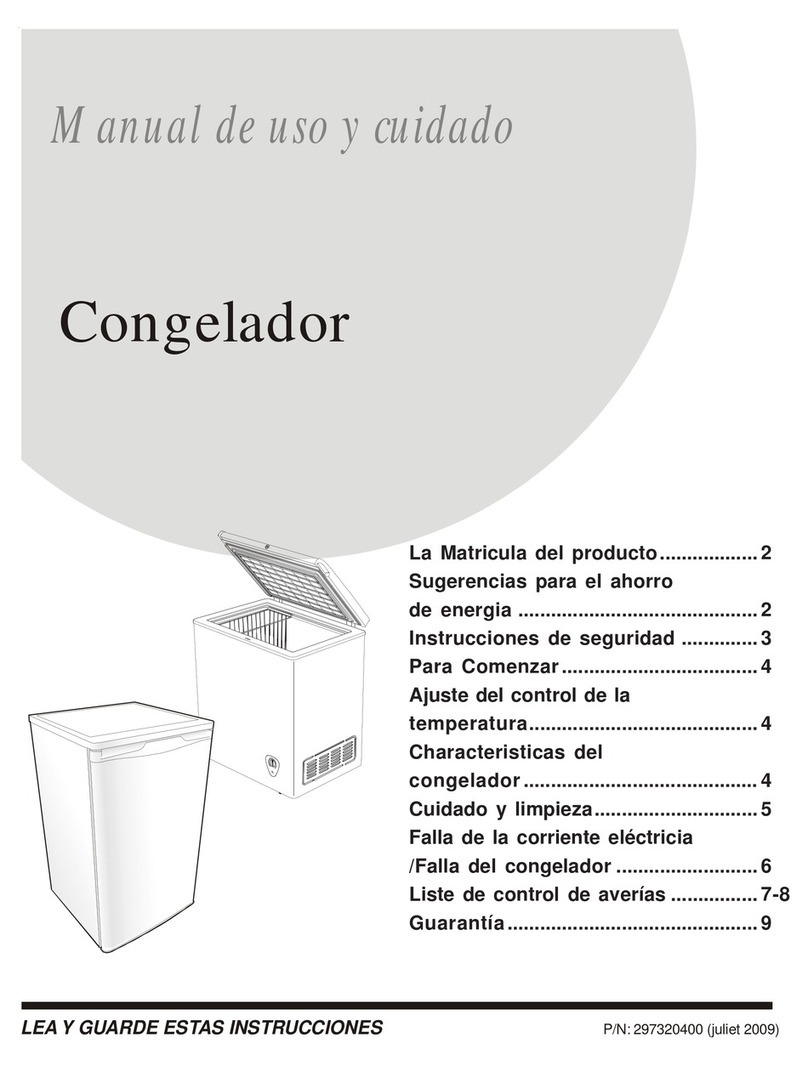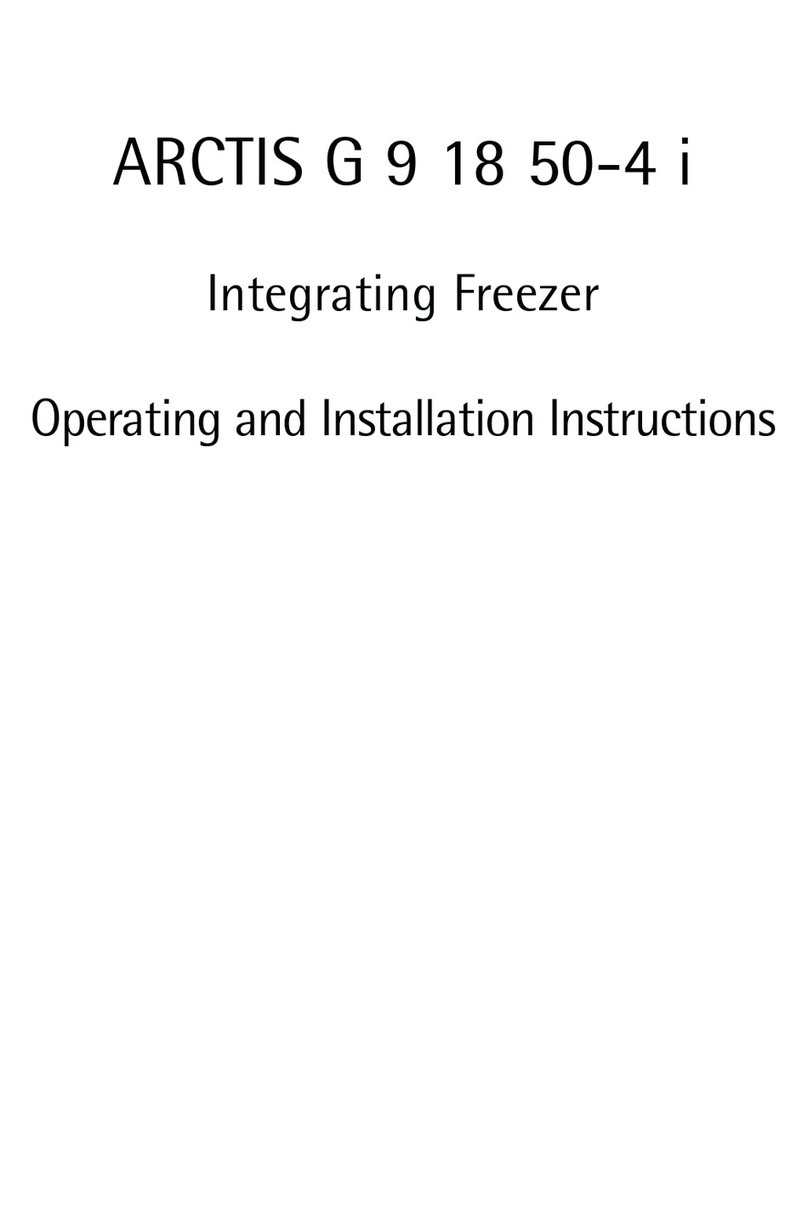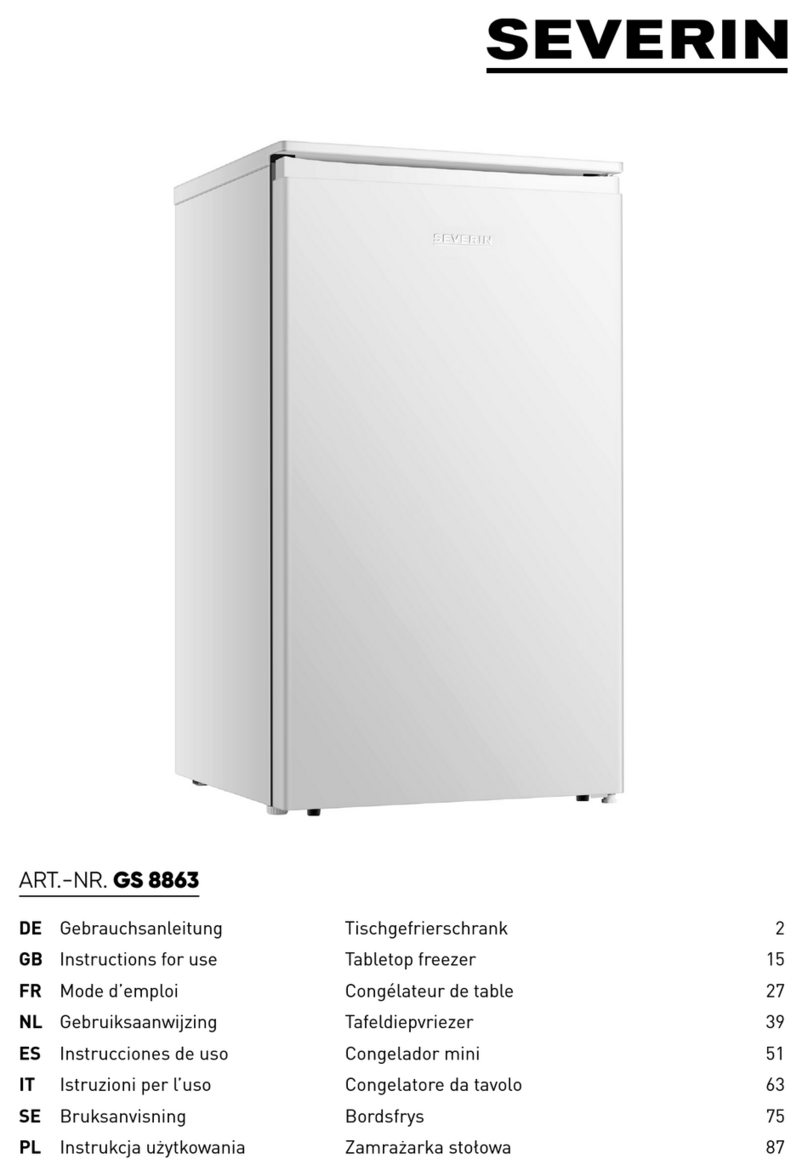Hesstar HCF-PD10R User manual

CHEST FREEZER
HCF-PD10R
Power
Run

SAFETY
WARNING!
It is hazardous for anyone other than authorized service personnel to carry out servicing or repairs which involves the
removal of covers. To avoid the risk of an electric shock do not attempt to repair this appliance yourself.
WARNING!
Risk of fire / flammable materials.
Safety tips
Do not use electrical appliances such as a hair dryer or heater to defrost your Freezer.
Containers with flammable gases or liquids can leak at low temperatures.
Do not store any containers with flammable materials, such as spray cans, fire extinguisher refill cartridges etc. in the Freezer.
Do not place carbonated or fizzy drinks in the Freezer compartment. Ice lollies can cause “Frost/Freeze burns”. If
consumed straight from the Freezer.
Do not remove items from the Freezer compartment if your hands are damp/wet, as this could cause skin abrasions or
“Frost/Freezer burns”. Bottles and cans must not be placed in the Freezer compartment as they can burst when the contents
freeze.
Manufacturer’s recommended storage times should be adhered to. Refer to relevant instructions.
Do not allow children to tamper with the controls or play with the Freezer. The Freezer is heavy. Care should be taken
when moving it. It is dangerous to alter the specification or attempt to modify this product in any way.
Do not store inflammable gases or liquids inside your Freezer.
If the power cable is damaged, it must be replaced by the manufacturer, its service agent or similarly qualified persons in
order to avoid a hazard.
This appliance is not intended for use by persons (including children) with reduced physical, sensory or mental capabilities,
or lack of experience and knowledge, unless they have been given supervision or instruction concerning use of the appliance
by a person responsible for their safety.
This refrigerating appliance is not intended to be used as a built-in appliance.
This appliance is intended to be used in household and similar applications such as
·staff kitchen areas in shops, offices and other working environments;
·farm houses and by clients in hotels, motels and other residential type environments;
·bed and breakfast type environments;
·catering and similar non-retail applications.
Keep ventilation openings, in the appliance enclosure or in the built-in structure, clear of obstruction.
Do not use mechanical devices or other means to accelerate the defrosting process, other than those recommended by the
manufacturer.
Do not damage the refrigerant circuit.
Do not use electrical appliances inside the food storage compartments of the appliance, unless they are of type
recommended by the manufacturer.

Do not store explosive substances such as aerosol cans with a flammable propellant inthis appliance.
This appliance is not intended for use by persons (including children) with reduced physical, sensory or mental capabilities,
or lack of experience and knowledge, unless they have been given supervision or instruction concerning use of the appliance
by a person responsible for their safety. Children should be supervised to ensure that they do not play with the appliance.
–WARNING: Keep ventilation openings, in the appliance enclosure or in the built-in structure, clear of
obstruction.
–WARNING: Do not use mechanical devices or other means to accelerate the defrosting process, other than
those recommended by the manufacturer.
–WARNING: Do not damage the refrigerant circuit.
–WARNING: Do not use electrical appliances inside the food storage compartments of the appliance, unless
they are of the type recommended by the manufacturer.
–WARNING: Refrigerating appliances –in particular a refrigerator-freezer Type I –might not operate
consistently (possibility of defrosting of contents or temperature becoming too warm in the frozen food compartment) when
sited for an extended period of time below the cold end of the range of temperatures for which the refrigerating appliance is
designed;
–WARNING: The necessity that, for doors or lids fitted with locks and keys, the keys be kept out of the reach of
children and not in the vicinity of the refrigerating appliance, in order to prevent children from being locked inside.
–WARNING: The refrigerant used in your appliance and insulation materials requires special disposal
procedures.
–WARNING: When positioning the appliance, ensure the supply cord is not trapped or damaged.
–WARNING: Do not locate multiple portable socket-outlets or portable power supplies at the rear of the
appliance
Children aged from 3 to 8 years are allowed to load and unload refrigerating appliances.To avoid contamination of food,
please respect the following instructions:
–Opening the door for long periods can cause a significant increase of the temperature in the compartments of the
appliance.
–Clean regularly surfaces that can come in contact with food and accessible drainage systems.
–Clean water tanks if they have not been used for 48 h; flush the water system connected to a water supply if water has
not been drawn for 5 days.
–Store raw meat and fish in suitable containers in the refrigerator, so that it is not in contact with or drip onto other food.
–Two-star frozen-food compartments are suitable for storing pre-frozen food, storing or making ice-cream and making ice
cubes.
–One-, two- and three-star compartments are not suitable for the freezing of fresh food.
–If the refrigerating appliance is left empty for long periods, switch off, defrost, clean, dry, and leave the door open to
prevent mould developing within the appliance.
Climate Range
The information about the climate range of the appliance is provided on the rating plate. It indicates at which ambient
temperature (that is, room temperature, in which the appliance is working) the operation of the appliance is optimal (proper).
Climate range
Permissible ambient temperature
SN
from +10°C to +32°C
N
from +16°C to +32°C
ST
from +16°C to +38°C
T
from +16°C to +43°C
Note:Given the limit values of the ambient temperature range for the climate classes for which the refrigerating appliance is
designed and the fact that the internal temperatures could be affected by such factors as location of the refrigerating
appliance, ambient temperature and the frequency of door opening, the setting of any temperature control device might have
to be varied to allow for these factors, if appropriate.
If the power cable is damaged, it must be replaced by the manufacturer, its service agent or similarly qualified persons in
order to avoid a hazard.
Note:When operating in an environment other than the specified climate type (i.e., beyond the rated ambient temperature
range), the appliance may not be able to maintain the desirable compartment temperatures.
Locks
If your Refrigerator is fitted with a lock, keep the key out of reach and not in the vicinity of the appliance to prevent children
being entrapped. When disposing of an old Refrigerator, break off any old locks or latches as a safeguard.

Freon-free
The freon-free refrigerant (R600a) and the foaming insulation material (cyclopentane) that is environmentally friendly are
used for the refrigerator, causing no damage to the ozone layer and having a very small impact on the global warming.
R600a is flammable, and sealed in a refrigeration system, without leakage during normal use. But, in case of refrigerant
leakage due to the refrigerant circuit being damaged, be sure to keep the appliance away from open flames and open the
windows for ventilation as quickly as possible.
NAMES OF THE PARTS
Due to technological innovation, the product descriptions in this manual may not be completely consistent with y
our freezer. Details are in accordance with the real product.
WARNING: Never touch the interior of the Freezer Chamber or frozen foods in the
compartment with wet hands as this could result in frost bite.
TRANSPORTATION INSTRUCTIONS
The appliance should be transported only in a vertical upright position. The packing as supplied must be intact during
transportation.
If during the course of transport the product has been transported horizontally, it must only be laid on its left hand side (when
facing the door front) and it must not be operated for at least 4 hours to allow the system to settle after the appliance is
brought back to upright position.
1. Failure to comply with the above instructions could result in damage occuring to the appliance. The manufacturer will not
be held responsible if these instructions are disregarded.
2. The appliance must be protected against rain, moisture and other atmospheric influences.
IMPORTANT : Care must be taken while cleaning / carrying the appliance to avoid touching the condenser metal wires at the
back of the appliance, as you might injure your fingers and hands or damage your product.
IMPORTANT : This appliance is not designed for stacking with any other appliance. Do not attempt to sit or stand on top of
your appliance as it is not designed for such use. You could injure yourself or damage the appliance.
IMPORTANT : Make sure that mains cable is not caught under the appliance during and after carrying / moving the
appliance, to avoid the mains cable becoming cut or damaged.”
When positioning your appliance take care not to damage your flooring, pipes, wall coverings etc. Do not move the appliance
by pulling by the lid or handle. Do not allow children to play with the appliance or tamper with the controls. Our company
declines to accept any liability should the instructions not be followed.
INSTALLATION INSTRUCTIONS
1. If possible avoid placing the appliance near cookers, radiators or in direct sunlight as
this will cause the compressor to run for long periods. If installed next to a source of
heat or refrigerator, maintain the following minimum side clearances:
From Cookers 4" (100 mm)
From Radiators 12" (300 mm)
From Fridges 4" (100 mm)
2. Make sure that sufficient room is provided around the appliance to ensure free air
circulation. Ideally, A space of no less than 10cm must be left around the freezer,
and ensure you allow gaps as shown in the below diagram.
3. The appliance should be located on a smooth surface.
4. It is forbidden to use the refrigerator outdoors.
5. Protection from moisture. Do not locate the freezer in moist space to avoid the metal
parts rusty. And do not spray water to the freezer, otherwise it will weaken the insulation and causes current leakage.
6. Refer to "Cleaning and Care" section to prepare your appliance for use.

7. If the freezer is installed in unheated areas, garages etc., in cold weather condensation may form on the outer surfaces.
This is quite normal and is not a fault. Remove the condensation by wiping with a dry cloth.
STARTING
Final Check
Before you starting to use the freezer, please check that:
1. The interior is dry and air can circulate freely at the rear.
2. Clean the interior as recommended under "CLEANING AND CARE".
3. Insert the plug into the wall socket and switch on the electricity supply,then the Red light is on. Avoid accidental
disconnection by taping over the switch. Green light will glow and the compressor will start running.
4. You will hear a noise as the compressor starts up. The liquid and gases sealed within the refrigeration system may also
give rise to noise, whether the compressor is running or not which is quite normal.
5. If you going to store already frozen food open the freezer lid and check that the freezer has reached the correct
temperature. Then you can put in your already frozen food.
6. Do not load the appliance immediately after it is switched on. Wait until the correct storage temperature has been reached.
We recommend that you check the temperature with an accurate thermometer.
Important Notes:
• If there is a power failure do not open the lid. Frozen food should not be affected if the failure lasts for less than 20
hours. If the failure is longer, then the food should be checked and eaten immediately or cooked and then refrozen.
• If you find that the lid of the chest freezer is difficult to open just after you have closed it, don’t worry. This is due to the
pressure difference which will equalize and allow the lid to be opened normally after a few minutes.
FREEZER OPERATION
The inside temperature of freezer is regulated by thermostat adjustment knob.
“1,2,3,4,5,6,7”marks on the knob do not represent the exact temperature, but show that the smaller number represent the
higher the temperature, conversely, the bigger number, the lower the temperature.
The following figure illustrates information as below:
“1(Refrigerator)”: Temperature range(5℃)
“2-4 (Freezer)”:Temperature range(-12~-18℃)
“4-7(Freezer)”:Temperature range(-18~-24℃)
"7 (Fast freezer )": Temperature range(below-24℃)
There is a deviation of ±3℃for each mode in different usage environments due to the mechanical control mode.
Please make fine adjustment according to the actual use condition.
Fast freezer (below -24℃):While set the knob to fast freezing range, please keep the compressor continuous operating
without stopping, the food can be quickly cooled.
Caution: Do not keep the knob on the fast freezing position after fast freezing
Refrigerating mode:
When change the refrigerating status to others, you should take out food to avoid them being frosted damaged. If shift
freezing or soft freezing satus to refrigerating mode, you should take the following steps:
Set the knob of thermostat to refrigeration mode, then remove all of frozen food from freeze compartment, then keep it being
empty for one hour, and finally put the required food into it.
Due to individual factors of the refrigerator, the actual temperature in the box may have a certain error from
the set temperature, which is a normal phenomenon and does not affect the normal use of the product.
STORING FROZEN FOOD
Prepackaged commercially frozen food should be stored in accordance with the frozen food manufacturer’s instructions for a
freezer compartment.
To ensure that the high quality achieved by the frozen food manufacturer and the food retailer is maintained the following

should be remembered:
1.Put packets in the freezer as quickly as possible after purchase.
2.Do not exceed “Use By”, “Best Before” dates on the packaging.
FREEZING FRESH FOOD
Place fresh food to be frozen near the side walls to ensure fast freezing and away from already frozen food, if possible.
Never exceed this maximum capacity. Do not freeze too large a quantity at any one time.
The quality of the food is best preserved when it is frozen right through to the centre as quickly as possible.
Take special care not to mix already frozen food and fresh food.
DEFROSTING
Defrost twice a year or when a frost layer of around 7 mm (1/4”) has formed.
Alternatively you may switch off the freezer at the socket outlet and pull out the mains plug.
Extract the water conduit and put in a water container.
6 hours before the defrosting, please set the thermostat knob at "7" position to make sure the food is at the lowest
temperature when you get it out. All food should be wrapped in several layers of newspaper and stored in a cool place (e.g.
fridge or larder).
Remove the freezer basket. Leave the lid open. Containers of warm water may be placed carefully in the freezer to speed up
the defrosting.
Never use hairdryers, electrical heaters or other such electrical appliances for defrosting. When defrosting has finished flow
out defrost water which collects at the bottom of the freezer as the below diagram and dry the interior thoroughly. Switch on
the Fast Freeze and leave it on for about three hours.
1.A drain outlet is designed at the bottom of the freezer liner, and when defrosting, remove its rubber
cover , then the defrosting water flows out and is discharged from the drain pipe.
2.Extract the water conduit by 20-25mm until the water hole can be seen.
3.Twist the water conduit until the arrow points downward.
4.After defrosting is done, make sure there is no more water coming out before out the water conduit in place and make the
arrow point upward.
Important Notes:
• Do not use pointed or sharp-edged objects such as knives or forks to remove the frost.
• Never use hairdryers, electrical heaters or other such electrical appliances for defrosting.
•It is normal that water beads or frosts appear on the freezer collar and door gaskets in the wet weather, which will not affect
the normal use. In such case, please clean it with a dry cloth in time!
CLEANING AND CARE
** We recommend that you switch off the freezer at the socket outlet and pull out the mains plug before cleaning.
** Never use any sharp abrasive instrument, soap, household cleaner, detergent and wax polish for cleaning.
** Use lukewarm water to clean the cabinet of the freezer and wipe it dry.
** Use a damp cloth wrung out in a solution of one teaspoon of bicarbonate of soda to one pint of water to clean the interior
and wipe it dry.
** Excess deposit of ice should be removed on a regular basis using a plastic ice scraper available from your local store.
Large accumulation of ice will impair the performance of the freezer.
** If the freezer is not going to be used for a long period of time switch it off, remove all food, clean it and leave the lid ajar.
** Check lid seals regularly to ensure they are clean and free from food particles.
Important Notes:
Never use water wash the compressor position, wipe it with a dry cloth thoroughly after cleaning to prevent rust.
DO’S AND DON’TS
Do –Defrost food from the freezer thoroughly in a fridge or in a microwave oven following defrosting and cooking
instructions.
Do –Ensure that chest freezer lid is completely closed after each use.
Do –Defrost frozen meat completely before cooking.
Do –Close the lid gently.
Do –Check contents of the freezer at regular intervals.
Do –Clean and defrost your freezer regularly (See “Defrosting”)
Do –Keep food for as short a time as possible and adhere to “Best Before”, “Use By” dates.
Do –Store commercially frozen food in accordance with the instructions given on the packets that you buy.
Do –Always choose high quality fresh food and be sure it is thoroughly clean before you freeze it.
Do –Prepare fresh food for freezing in small portions to ensure rapid freezing.
Do –Wrap all foods in aluminum foil or freezer quality plastic bags and make sure any air is excluded.

Do –Wrap frozen food when you buy it and put it in to the freezer as soon as possible.
Do –Store small items in the basket provided.
Do –Remove ice cream from the freezer 10-20 minutes before serving.
Don’t – Leave the lid open for long periods as this will make the freezer more costly to run and cause excessive ice
formation.
Don’t – Use pointed sharp edged objects such as knives, forks to remove the ice.
Don’t – Put hot food in the freezer. Let it cool down first.
Don’t – Put liquid-filled bottles or sealed cans containing carbonated liquids into the freezer as they may burst.
Don’t – Store poisonous or dangerous substances in the freezer. Your freezer has been designed for the storage of edible
foodstuffs only.
Don’t – Consume ice-cream and water ices direct from the freezer. The low temperature may cause ‘freezer burns’ on lips.
Don’t – Freeze fizzy drinks.
Don’t – Try to keep frozen food which has thawed, it should be eaten within 24 hours or cooked and refrozen.
Don’t – Remove items from the freezer with wet hands.
Don’t – Shut the lid with force. You will damage the appliance.
• This appliance is not intended for use by persons(including children) with reduced physical, sensoryor mental capabilities,
or lack of experience andknowledge, unless they have been given
supervision or instruction concerning use of theappliance by a person responsible for their safety.
• Children should be supervised to ensure that theydo not play with the appliance.
• Do not store explosive substances such as aerosolcans with a flammable propellant in this appliance.
• This appliance is intended to be used in householdand similar applications such as staff kitchen areas in shops, offices and
other working environment farm houses and by clients in hotels, motels and other residential type environments;bed and
breakfast type environments catering and similar not-retail applications.
• If the supply cord is damaged, it must be replaced by manufacture, its service agent or similarly qualified persons in order to
avoid a hazard.
ELECTRICAL INFORMATION
THIS APPLIANCE MUST BE EARTHED.
This appliance is fitted with a fused three pin plug to BS 1363 which will be suitable for use in all houses fitted with sockets to
current specifications.
If the fitted plug is not suitable for your socket outlets, it should be cut off and carefully disposed of. To avoid a possible shock
hazard, do not insert the discarded plug into a socket.
This appliance complies with the EEC Directives:
Correct Disposal of this product
This marking indicates that this product should not be disposed with other household wastes
throughout the EU. To prevent possible harm to the environment or human health from uncontrolled
waste disposal, recycle it responsibly to promote the sustainable reuse of material resources. To
return your used device, please use the return and collection systems or contact the retailer where the
product was purchased. They can take this product for environmental safe recycling.
Warnings for disposal
※Refrigerant and cyclopentane foaming material used for the refrigerator are flammable.
Therefore, when the refrigerator is scrapped, it shall be kept away from any fire source and be
recovered by a special recovering company with corresponding qualification other than be
disposed by combustion, so as to prevent damage to the environment or any other harm.
※When the refrigerator is scrapped, disassemble the doors, and remove gasket of door and
shelves; put the doors and shelves in a proper place, so as to prevent trapping of any child.
Table of contents
Other Hesstar Freezer manuals
